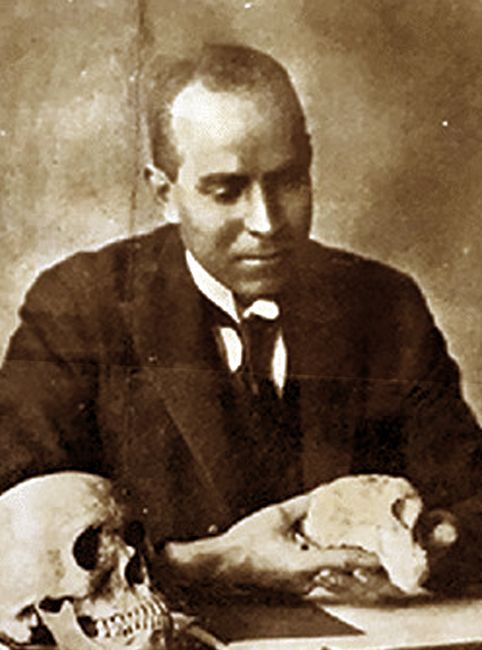Athena Review Image Archive ™
Raymond Dart (1925)

Portrait of Raymond Dart holding the Taung skull (photo: Witwatersrand University, 1925).
Raymond
Arthur Dart (1893–1988), an Australian-born anatomist and
paleoanthropologist who worked in South Africa, was the discoverer of
the Taung child, and the first scientist to recognize an
australopithecine.
After attending medical school in Sydney,
Dart served in World War I as a doctor. In 1922, he became a professor
of anatomy at the University of the Witwatersrand in
Johannesburg. In 1924 he found a skullcap in a quarry at Taung
that fit precisely over a brain-cast protruding from the surface of one
of the rocks. Once the skull was removed, it was recognized by Dart to
be a juvenile of an early hominin, which Dart named Australopithecus africanus (“southern ape of Africa”).
In a 1925 paper published in Nature, Dart proposed that A. africanus represented a missing link between apes and humans, since it combined humanlike teeth and upright posture with a small cranial capacity. Dart's find was dismissed by the originators of the spurious Piltdown fossil, which showed an ape's features with a human size brain (the opposite of Dart's accurate view). The Taung find also became overshadowed by the 1930 discovery of a largely intact Homo erectus skull at Zhoukoudian, China.
In the 1930s, however, Dart became friends with Robert Broom, and in 1936 Broom discovered the fragmentary skull of an adult australopithecine at Sterkfontein cave. In 1938, he described and named Paranthropus robustus (Broom 1938) based on a skull found at Kromdraai. In the 1940’s, encouraged by Broom, Dart returned to fossil hunting and found more australopithecine remains in a cave at Makapansgat.
References:
Copyright © 1996-2020 Rust Family Foundation (All Rights Reserved).